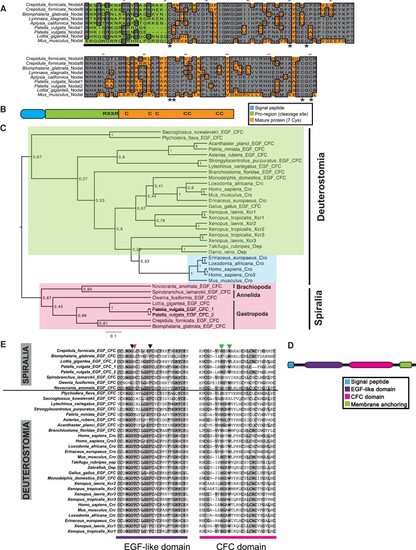Fig. 1
- ID
- ZDB-FIG-230717-133
- Publication
- Truchado-García et al., 2022 - A small change with a twist ending - a single residue in EGF-CFC drives Bilaterian asymmetry
- Other Figures
- All Figure Page
- Back to All Figure Page
|
Two paralogs for Nodal are present in Crepidula fornicata, and EFG-CFC orthologs are present in non-deuterostomes. (A) Alignment of several ortholog proteins for Nodal in different gastropod species (C. fornicata; Biomphalaria glabrata; Lymnaea stagnalis; Aplysia californica; Patella vulgata; Lottia gigantea) and mammalian Mus musculus. Gray indicates conservation for one given position; asterisks point the seven conserved cysteines that characterize the family; bar delimits the regions were cleavage sites are located. (B) Generic structure of Nodal protein. C, cysteines; (RXXR), cleavage site. (C) EFG-CFC proteins inter-relationships. Bayesian phylogenetic tree of EFG-CFC inferred proteins from spiralian species, along with previously described sequences of other bilaterians (supplementary S1, Supplementary Material online). The WAG model (Whelan and Goldman 2001) was selected as the best-fit model of protein evolution using ProtTest (Abascal et al. 2005). Tree shown is the result of Bayesian analysis, run for 25,000,000 generations, and analyses run until the SD of split frequencies was below 0.01, with the first 25% of sampled trees discarded as “burn-in.” Posterior probabilities can be seen at each branch. Scale bar represents substitutions per site at given distances. Shading shows major protein lineages. (D) Generic structure of EGF-CFC protein. (E) Alignment of the EGF-like and CFC domains of several ortholog proteins for Cripto, Cryptic, and EGF-CFC in different bilaterians, from both Spiralia and Deuterostomia clades. Shading indicates conservation for one given position. Arrowheads indicate the relevant positions in the ligand-receptor-coreceptor binding; Gly and Phe (black arrows) are conserved, whereas Thr, described as necessary for Nodal signaling, is only present in chordates and some lineages of echinoderms, and is variable in spiralians (red arrow); His and Trp (green arrows) are conserved in all orthologs with the exception for Spirobranchus and hemichordates. |

